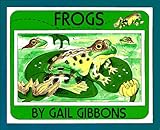Lesson 1: Identifying Information in Nonfiction
Lesson Plan
Frogs | 600L

- Learning Goal
- Identify explicit information in nonfiction.
- Duration
- Approximately 50 minutes
- Necessary Materials
- Provided: Example KWL Chart for Direct Teaching and Guided Practice, Independent Practice Worksheet
Not Provided: Frogs by Gail Gibbons, chart paper, markers
-
Teacher Modeling

will explain the purpose of a KWL chart. (Example is provided). I will guide the class in identifying what they already know and what they want to know about frogs. For example, I know that frogs are green I wonder if some frogs are other colors too? I will put what I know under “K” on my KWL chart and what I want to know under “W”. I will begin reading Frogs by Gail Gibbons. I will identify the first fact that I learn from reading the text. I will explain that this is explicit information: it is information “right there” in the text. I know that frogs begin life as small eggs in a wet place. I know this because it tells me so in the text.
-
Think Check
Ask: "How did I learn information from the text?" Students should respond that you read the text and found information "right there" in the text.
-
Guided Practice

will continue to listen to Frogs, and we will identify the information we learn while listening to the book. We will chart information in the “L “(Learned) part of the chart. (See example KWL chart provided.) We will answer our questions about frogs by going back to the text and finding the information “right there” in the text.
TIP: When identifying information learned from the text, have students lead you in the information they remember. It is not necessary to write down every fact from the book. Have students highlight what is most interesting to them.
-
Independent Practice

will identify one fact you learned about frogs from the book. (Independent Practice Worksheet is provided.)
TIP: Remove the KWL chart before students complete the Independent Practice. Students may need access to the book to complete the Independent Practice. Provide vocabulary cards or a list of vocabulary words for students to refer to when writing the facts they learned about frogs for the Independent Practice. (tadpole, eggs, adult, hatch, lungs, legs, tail, water, land, gills, etc.)
Texts & Materials
Standards Alignment
(To see all of the ReadWorks lessons aligned to your standards, click here.)



Great ideas to be implemented in my class.
For the k on the chart, I like to say what they "think" they know. That way you can more easily address misconceptions.